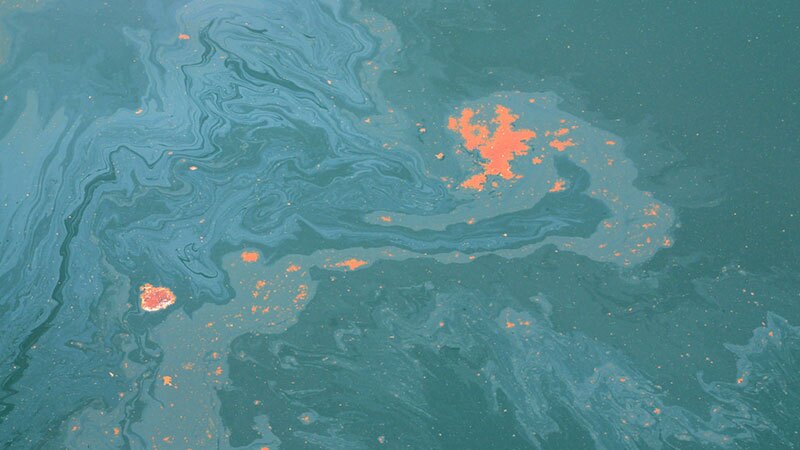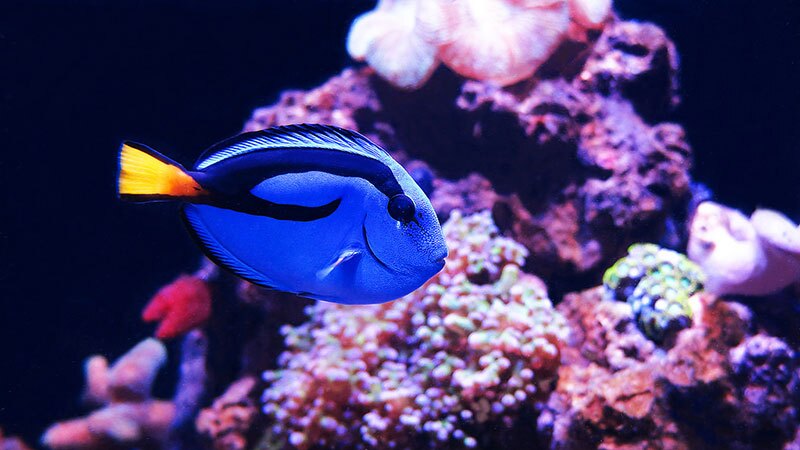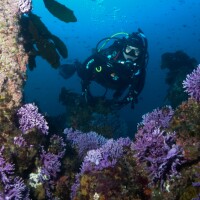Coral Reefs Are Threatened by More Than Just Climate Change


Coral reefs are in danger, and our dumping way too much carbon dioxide into the atmosphere is a big reason why. Climate change is warming the oceans and raising sea level, and that extra CO2 dissolved in seawater is literally undermining the foundations of coral reef ecosystems worldwide.
But these delicate rainforests of the sea face a lot of other problems, and most of them are a result of human activity. Even if we solved the climate problem overnight — which would be a good idea — coral reefs would still be in trouble. Here are some of the reasons why.
Fishing practices
Coral reefs occupy less than one quarter of one percent of our oceans, but they’re home to an estimated 25 percent of all marine life. That means that on average, coral reefs have 100 times more marine life per square mile than the rest of the ocean.
That superabundance of marine species includes the coral polyps themselves, mussels and crustaceans, sponges and other invertebrates, sea turtles, seahorses, and bony fish. About a quarter of the ocean’s fish species rely on coral reefs as a sheltered environment in which to deposit their eggs, giving young fish a bit of protection after they hatch.
So it’s no accident that coral reefs are disproportionately affected by the fishing industry: if you want to catch a fish, you go where the fish are.
People have harvested fish near coral reefs for centuries, and a significant proportion of ocean fish in markets today comes from fish that depend on, and hang out near, coral reefs. In 2001, the National Oceanic and Atmospheric Administration (NOAA) estimated that commercial fishing near coral reefs was a $100 million a year industry in the U.S. alone. In some parts of the world, reefs are the source of as much as a quarter of the seafood sold locally.

As demand for fish grows and pressure on fish intensifies, the coral reefs of the world are taking the hit. Industrial fishing boats that use trawl nets scrape the ocean floor. That’s a practice that’s destructive just about anywhere at sea, but especially so at coral reefs, whose delicate skeletons of calcium carbonate break off easily. Discarded fishing nets such as driftnets can also become entangled in corals and break polyps off the reef.
Industrial fishing boats are taking more and more of the oceans’ fish, and that means subsistence and small-scale fishermen who might have used less destructive methods in the past are increasingly resorting to drastic measures to catch reef fish. Some use “blast fishing,” in which a stick of dynamite is thrown into the water near a reef; when it explodes, stunned fish float to the surface where they can be scooped up.
Even recreational fishing near coral reefs — in the U.S., an industry larger than commercial coral reef fishing, according to NOAA — can damage reefs, as everything from fishing tackle to boat anchors can damage and dislodge corals.
And then there’s the simple matter of overfishing, which can harm coral reef ecosystems by changing the local ecological balance.
What you can do: Make sure the seafood you eat is harvested as sustainably as possible. The Monterey Bay Aquarium offers apps and other information to help you make the right choices in the store.

Disruptions and invasions
The canonical example of how overfishing can damage coral reefs doesn’t involve a fish harvested for food, but instead a sea snail, the giant triton. The giant triton is in great demand for its shell, which is used mainly as a decoration. The triton is also one of the few known predators of the crown of thorns starfish, a foot-wide, 21-armed sea star that eats coral. The crown of thorns is an integral part of reef ecosystems in the Indo-Pacific region near Australia, as long as its population is kept in check. In some reef areas, depletion of tritons has been linked to serious outbreaks of crown of thorns starfish, and those outbreaks can devastate large sections of a reef in short order. Not all scientists agree that overharvesting of tritons is primarily responsible for starfish outbreaks, but it certainly doesn’t help.
Some human disruptions of coral reef ecosystems aren’t done on purpose. Coral polyps survive through an intimate partnership with small photosynthesizing microorganisms called zooxanthallae, which are incorporated into the polyp’s body. There, they photosynthesize light filtering through the seawater, turning it and CO2 into food, which they share with the polyp, allowing both to survive.
When ships release ballast water near coral reefs, that water often contains exotic species of algae, which can start growing on the reef. Algae can also be introduced as fouling on a ship’s hull, on scuba gear that’s insufficiently cleaned after diving in algae-rich waters, or through dumping of aquaria into the sea. Once a large form of algae takes hold, it can reproduce rapidly and cover much of the reef in a short time. That shades out the coral polyps and their zooxanthallae, which starve and die. Reefs invaded by algae become far less useful as habitat, which results in collapse of the local ecosystem as other reef dwellers die or move away.

Lionfish are another species causing damage to coral reef ecosystems. Native to reefs in the Indo-Pacific region, lionfish were introduced to reefs in the Atlantic and Caribbean in the 20th Century — probably on multiple occasions by aquarists and their suppliers dumping captive lionfish into the ocean.
Lionfish are very active predators: one study of reefs in the Caribbean and Atlantic found that they readily consume more than 40 species of reef fish. In their native range, lionfish are eaten by everything from sharks to groupers to moray eels, and smaller fish and birds help out by eating floating lionfish egg sacs. In the Atlantic, groupers have been found to eat lionfish, and that's good news for reefs where groupers are abundant. But groupers have been over-fished in many places. Where there are few groupers, lionfish can prosper.
As a result, lionfish have spread rapidly throughout the reefs of the western North Atlantic and the Caribbean, where they can denude a reef of the majority of its small fish — including juvenile members of much larger species, like the groupers that might have grown up to control lionfish numbers. That loss of fish has many possible effects that biologists are still sorting out, but one certain result is a loss of larger fish such as grouper who can’t find food, because lionfish have eaten it all. A lionfish invasion can reduce the biological diversity of a coral reef by 80 percent.
What you can do: Don’t ‘liberate” fish and plants from your salt water aquarium by dumping them into the ocean. Clean your water gear, from wetsuits to boats to surfboards, when traveling to reef country. Investigate your vacation hosts' environmental practices, and stay only with those businesses that work to reduce their impact. And if you eat fish, consider adding lionfish to the menu.

Recreation
Reefs can get loved to death. Their startling beauty and biodiversity attracts visitors reliably enough to power the economies of many coastal communities. But the influx of people takes its toll on the reef ecosystem.
The most direct damage comes from divers’ physical presence near the reef. Careless anchoring, as with fishing boats, can damage reefs. So can an errant swim fin, tank, or other diver body part. Even just touching a coral can cause damage, perhaps killing the polyp and its neighbors by introducing infection. The amount of damage an individual diver can do might be minimal, but multiply it by tens of thousands of divers in a season — millions in some places —and the damage mounts.
And then there’s the infrastructure set up to host the tourists. Small coastal communities, especially in places without stringent environmental protection laws, can seriously harm the reefs that provide their livelihood through sewage dumping, runoff of oil and other pollutants, and even construction of new hotels, which can cause sediment to run off into the ocean.
One surprising way in which recreation can kill reefs: coral polyps and their zooxanthallae are extremely sensitive to the UV blockers in sunscreen: a very small amount can kill off a surprisingly large swathe of reef.
What you can do: investigate whether your destination follows environmental best practices such as pollution control. Dive coral-safe: there are resources you can use to learn how. And go easy on the sunscreen: cover up with a long-sleeved shirt, trousers, or wetsuit instead.

Pollution
As of 2010, 44 percent of us worldwide live within 100 kilometers —62 miles and change —of a coastline. That’s three and one-quarter billion people, and we generate a whole lot of waste. Sewage laden with plant nutrients, pathogens and pharmaceutical compounds can flow into the ocean from even the most environmentally conscientious communities. Near reefs, the extra plant food from sewage can boost growth of invasive algae, and many common chemical contaminants can kill corals or the animals that live with them.
Silt runoff, mostly from agriculture, can smother reefs both through depriving reef animals of oxygen, as the organic matter in the silt breaks down, to literally smothering the reefs: even a thin layer of silt will keep that all-important sunlight from reaching the zooxanthallae.
Another kind of pollution coral biologists have their eye on is microplastic. These tiny particles of plastic, the breakdown products of our grocery bags, plastic straws, bicycle helmets and water bottles, are increasingly ubiquitous in the ocean. Though coral do get a significant amount of food from their zooxanthallae, they also eat plankton out of seawater. Studies show that corals can’t distinguish between plankton and microplastic, and consume the latter in significant amounts. No one’s sure yet precisely what effect this has on coral polyps. But there’s some chance that the inert plastic could interfere with normal feeding, and it’s been established that microplastic particles tend to collect chemical pollutants dissolved in seawater.
Oil spills, as you might expect, are particularly hazardous to corals, in part because they can interfere with an entire year’s worth of reproductive cycle. Corals spawn to reproduce: all at once, responding to some cue scientists haven’t quite puzzled out yet, all the corals in a reef will release egg and sperm cells, which float to the surface. There, those eggs that are successfully fertilized by sperm develop into coral larvae, called planula. The planula drop to the ocean floor, where — if they’re lucky — they’ll find something hard to hold onto at the right depth to start building a reef, or adding to an existing one.
That means oil floating on the surface can kill an entire generation of coral all at once. If the oil spill is treated with dispersants, the oil will sink to the seabed, where it can cause further serious injury to reefs.
What you can do: Participate in a beach cleanup, which is the most effective way of dealing with plastic already dumped in the ocean. Reduce your consumption of disposable plastic items. Dispose of used motor oil and household chemicals at recycling or hazardous material collection sites instead of dumping them into the storm drain. And perhaps most importantly, advocate for stronger pollution control laws.

The tropical fish trade
It’s a little ironic. The plot of Pixar’s 2003 movie "Finding Nemo" centered on how cruel it was to take the little clownfish Nemo from their coral reef habitat and confine them in salt water aquaria. People saw the film, enjoyed it, and then responded by trying to get their own clownfish to keep in an aquarium. According to the group Saving Nemo, a huge spike in retail clownfish sales followed the film’s release.
The problem: at that time, almost all the clownfish sold in retail stores in affluent countries were captured from the wild, from the coral reefs on which they live.
It’s not just clownfish: the vast majority of tropical fish sold to salt water aquarium hobbyists are wild-captured. Of around 1,800 species of reef fish sold commercially, only a few are being raised commercially. A full 98 percent of saltwater animals sold to hobbyists, from fish to crabs to living corals, are wild-caught. And the majority of those animals collected don’t live long enough to reach the retail store.
For every tropical reef fish you see in pet stores, at least nine others died on their way from the reef to the store.
In 2008, NOAA reported that about 90 percent of the 11 million reef fish sold commercially each year in the United States are caught using sodium cyanide, which collectors squirt onto reefs. Cyanide in the proper concentration stuns the fish, which can then be scooped up easily and transported. Cyanide kills about ten square feet of reef for every single fish captured, and it kills a fair number of the fish as well — though they may take several weeks to die of the poison.
Several nations have banned cyanide fishing, but enforcement is often lax to nonexistent. Groups like For the Fishes are campaigning to educate aquarists about the downside of their hobby, and conservation groups are urging the United States to begin testing imported fish for traces of cyanide. Federal law prohibits importation of wildlife caught in ways that are illegal in the country of origin.
Since "Nemo’s" release breeders have started producing clownfish commercially. This could potentially mean an end to wild-caught clownfish, though to date only a quarter of commercially available clownfish are captive bred.
And the 2016 release of "Nemo’s" sequel, "Finding Dory," heightened fears among conservationists that the spike in clownfish demand could play out again with blue tangs, the species to which the Ellen DeGeneres-voiced Dory belonged. While clownfish are only moderately difficult to keep healthy in captivity, blue tangs are very difficult. They require a large amount of space (aquarists recommend an eight-foot-long tank at a minimum for a single blue tang), and, given expert and expensive care, can live for decades.
A surge in demand for blue tangs carries with it one threat the clownfish boom lacked: while captive breeding might reduce wild clownfish collection, no such option seems to exist for blue tangs, who are surpassingly reluctant to reproduce in captivity. Aquarium fish suppliers won’t be breeding blue tang clans in captivity anytime soon, which means that every captive blue tang represents perhaps nine that died on the way to the retailer, and about 100 square feet of dead reef. The same goes for almost all of the other saltwater aquarium species now available for purchase in the U.S.
What you can do: If you keep a salt water tropical aquarium, make sure your fish are purchased ethically. Choose species that aren’t at risk in the wild, so that even if your supplier misinforms you, your purchase is unlikely to deplete populations at risk — though remember, capture itself can destroy a large amount of coral reef. For the Fishes has released an iOS app called TankWatch, which will guide hobbyists through the process of making ethical purchases. The group says an Android version will be available soon. And whatever you do, don’t “liberate” any tropical fish into the ocean, whether they’re clownfish or lionfish. Even if they’re native to the part of the ocean where you release them, they can spread diseases caught in captivity to wild populations.
Banner: Coral Reef at Palmyra Atoll National Wildlife Refuge. Photo: Jim Maragos/USFWS


